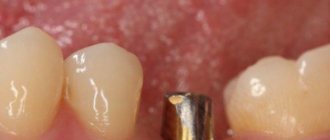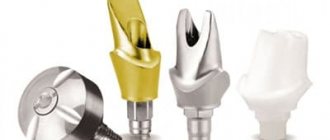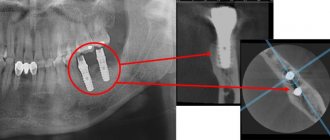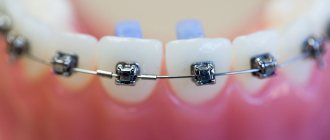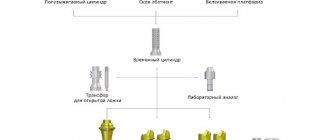From this article you will learn:
- what are abutments in dentistry,
- their options are standard and individual,
- what type of abutment is better to choose.
An abutment is a structure that is installed in a dental implant and is necessary to fix a crown or prosthesis on it. The lower part of the abutment is built into a special space inside the implant, while the upper part is an analogue of the stump of a tooth ground for a crown. Thus, abutments are a kind of “adapter” between implants and crowns (prostheses), necessary for fixing the latter to the implants.
There are a large number of abutment options in dentistry (varying in price by 3-5 times), and you should not underestimate their importance. Despite the fact that this is just some kind of “adapter”, not only the aesthetics of the entire structure, but also its service life will depend on the type and quality of the abutment. Abutments for implants can be made of titanium, zirconium dioxide (ceramics), or a hybrid version - of zirconium dioxide on a titanium base. There is also an economical option for abutments made of cobalt-chromium alloy (CHS).
Abutment options in dentistry –
Abutments can also be standard or customized. Standard abutments are ready-made “abutments out of the box”, which each manufacturer produces in several standard sizes. Their main disadvantage is the shape of their neck (transgingival part of the abutment), which will not correspond to the topography of the gums around the implant. Although this is very important, because... The gum will be directly adjacent to the neck of the abutment. Just small deviations from the ideal diameter or from the required angle of inclination of the upper part of the abutment can immediately lead to unsatisfactory esthetics.
If the diameter of a standard abutment is slightly smaller, it will not support the gum tissue well (which may require surgical reconstruction of the gum around the implant in the future). Or the abutment, on the contrary, can put pressure on the gum, and this often leads to peri-implantitis, i.e. to inflammation of the gums and destruction of the bone around the implant. At a minimum, this will mean a reduction in its service life, but sometimes it can result in rejection of the dental implant. Therefore, ideally, the abutment should only be individual - made of titanium or zirconium dioxide.
Implant abutment: what is it, the functional purpose of the element
Dental implants are a special type of structure that is used in dentistry to restore lost teeth. The design consists not only of the implant itself - a titanium rod implanted into the bone tissue of the jaw; it includes several elements at once, including an abutment, which can be called an adapter between the implant and the crown.
In the article we will talk in detail about what an abutment is, what functional tasks this element of the implantation system solves, and what types of abutments exist.
Calculate the cost of treatment by taking a short test in 20 seconds!
Do not delay your treatment, because in this matter time plays against us.
Features of care
types of individual abutments are distinguished by shape : angular, spherical, gum former.
Regardless of the type, the individual device requires special care.
- In the first days after surgery, it is forbidden to use any toothbrush; only rinsing with aseptic solutions and soda is recommended.
- From day 5, the use of brushes with soft bristles is allowed; the paste should not contain abrasive elements that can damage the abutment.
- It is forbidden to eat solid foods, sweets, or drink drinks with dyes until the permanent crown is installed.
- Smoking and drinking alcohol is prohibited.
What is a dental implant abutment?
Dental implantation is a progressive technology for restoring lost teeth, but ordinary people have too superficial an understanding of how the operation of implantation is carried out and, even more so, of the structural design of dental implants. The abutment is one of the main parts of the implant system and its purpose is to connect the implanted titanium rod to the dental crown.
It is impossible to install a crown on an implant without an abutment; in addition, the service life of the prosthesis, its functionality, and aesthetic appearance depend on this element. Just a few years ago, manufacturers of implantation systems offered only one option for abutments - a standard design. These days, dental brands produce entire lines of abutments, which may differ from each other in appearance, shape, and production material.
We will talk in detail about the types of abutments in the next section of the article.
Features, pros and cons of implantation
Today, implantation is one of the most advanced technologies for restoring teeth. Its advantages: high comfort (the patient does not feel the prosthesis as a foreign body in the mouth), physiological load on the jaws and prevention of bone tissue atrophy. The disadvantages include the complexity of medical procedures, as well as the risk of rejection.
The technology is improved every year, new protocols appear, current materials are used, an individual abutment , which improves the solidity of the structure and prevents the formation of inflammatory processes.
Classification of abutments into types, overview of the characteristics of different types of structures
Abutments are classified according to a set of performance characteristics, as well as by area of application. Let's look at the most popular types of abutments in modern dental implantation.
Standard abutments
They are universal designs, manufactured according to templates.
Standard abutments are produced in different sizes, diameters, and various shapes. Suitable for use in a wide variety of clinical situations. The price of standard abutments is quite reasonable; if necessary, it is easy to remove and replace the structure with a new one. With all the advantages, standard design abutments also have a number of disadvantages:
They do not provide the opportunity to obtain ideal aesthetics in the gum area;
May not be suitable for a patient with anomalies in the structure of the dental system;
When choosing a standard abutment, an additional and thorough quality check is definitely recommended.
Custom abutments
This type of construction is so called because the abutment is made individually for each patient.
To produce an individual abutment, a virtual model of the jaw in 3D format is used, and therefore the finished abutment will take into account all the anatomical features of the patient’s dental system. Pure titanium is most often used for the manufacture of structures; they can also be made from zirconium dioxide. The advantages of individual abutments include the following characteristics:
High quality, strict compliance with the characteristics of the anatomical structure of the jaw;
Improved aesthetics and functionality;
A tighter and better fit to the gum line, which eliminates the need for additional manipulations with sensitive tissues of the oral cavity;
There is only one drawback of individual abutments - high cost, but it is fully compensated by the benefits that the patient can receive by choosing abutments made personally for him.
Angled abutments
Used for installation on implants implanted at a non-standard angle. Angled abutments are in demand when performing implantation in patients with a non-standard structure of the dental system. Thanks to the unique type of design, which provides for a certain angle of inclination, it is possible to achieve the most durable connection between the implant and the crown.
Ball abutments
Abutments of this type are spherical in shape and are used during mini-implantation operations.
A conditionally removable denture is usually fixed on spherical abutments. Separate types of products are temporary and solid abutments. The first type of abutment is a plug that is placed on the implanted implant and contributes to the process of forming an aesthetic relief of the gums at the site of the operation. After the titanium rod has healed, the temporary abutment is removed.
In one-stage implantation, systems can be used in which the implant and abutment act as a single whole. After implantation of such an implant, a temporary crown is immediately placed on it.
Origin of the word
The name abutment comes from the English word abutment, which means “support”. An abutment is a transitional part between an artificial root and a crown or prosthesis. An implant is a screw that is installed into the bone under the gum. The abutment acts as a plug, preventing saliva, food debris and plaque from entering the implant cavity. It allows the gum to form around the implant, and also serves as a support for the crown or a fixation device for the prosthesis, which is attached to the implant.
The abutment is, on the one hand, a cylinder or screw that is screwed to the implant, and on the other, a small cone on which a crown is installed or a prosthesis is attached.
Abutment materials
The material used to produce abutments is important because it affects both the functionality of the prosthesis installed on the implant and the aesthetics of the implantation result. According to the material of manufacture, abutments are:
Titanium abutments
Titanium abutments are in greatest demand on the market due to the optimal combination of price and quality. They have excellent strength and reliability, but do not always provide the desired aesthetics, since titanium can noticeably show through the crown.
Zirconium abutments
They are the most expensive type of product, especially if you plan to use an individual zirconium abutment in the operation. Abutments made of zirconium dioxide provide impeccable aesthetics of restorations and have no analogues in terms of strength and durability.
Combined abutments
Manufactured from a titanium-zirconium alloy, they allow you to obtain the optimal combination of functionality and aesthetics, but the price of the products will be quite high, and in addition, combined abutments are presented in the lines of a small number of manufacturers of implantation systems.
Ceramic abutments
An ideal solution for patients with allergic reactions to metals and their alloys.
Ceramic abutments can be successfully used for implantation and restoration of teeth included in the smile zone. A separate type of product is plastic abutments - they are used exclusively for temporary restorations and are subsequently replaced by structures made of more durable and reliable materials.
Basic types of fastening
For standard and individual abutments, there are two types of fastening: cement and screw.
Cement involves the use of special fixing mixtures. There is no alternative method of fastening if the screw method is not possible. There is a risk of the solution getting into soft tissues and causing an inflammatory process.
The screw fastening is reliable, provides excellent fixation, and is well suited for chewing teeth where high loads are expected. Installation requires the dentist's expertise to properly tighten the threads and not place excess stress on the implant.
By contacting our clinic, you can receive detailed advice on each method and qualified assistance from a specialist.
Installation and fixation of the abutment on the implant
If a one-stage implantation is carried out, then the implant and abutment are installed simultaneously and usually one-piece structures are used in this type of operation. After implantation of a titanium rod with an abutment, the implant is immediately loaded with a temporary crown. When carrying out implantation according to the classical protocol, the installation of all elements of the implantation system is divided into several successive stages:
1. General preparation for surgery (consultation, diagnosis, panoramic image, preliminary treatment, sanitation of the oral cavity);
2. Installation of an implant into the jaw bone. A gum former is placed on the implant - a temporary plug that allows you to achieve an attractive gum relief in the implantation area.
3. Installation of the abutment (performed after complete osseointegration of the implant);
4. Installation of the crown.
Fixation of the abutment to the implant can be done in two ways:
Using cement. The technique is simple and reliable, but requires care when removing excess cement mortar. There shouldn't be any left! In addition, if it is necessary to remove the crown, certain difficulties may arise;
Using screw type fasteners. A hole is made in the crown and the abutment screw is inserted through it. After installing the abutment and crown on it, the hole is masked with material and polished.
The screw fixation technology will help you easily remove the crown and abutment if necessary, but at the same time, the screw fastening of the abutment is inferior in reliability to traditional cement fastening, as it increases the risk of structure breakage.
Possible complications
If the patient takes proper care of the oral cavity, but the inflammatory process intensifies every day (the gums swell, discharge forms at the site of the abutment), then you should immediately consult a doctor. It is worth noting that such complications occur rarely, and they are quite easy to cure.
If the abutment is not securely fixed (it wobbles), the tight connection with the implant is broken, as a result of which the soft tissues surrounding the product can become inflamed or infected. If an infection occurs or the slightest suspicion of this, you should also consult a doctor for help.
Reimplantitis
The absence of a special anti-rotation mechanism in the abutment design can lead to its fracture. This mechanism is responsible for stable and reliable fixation of the element. If this happens, you need to unscrew the abutment. Of course, this can only be done by a qualified specialist, so you cannot self-medicate. Learn how to pull out a child's tooth by following the link.
Is it possible to replace an abutment that has become unusable?
Under certain circumstances, any element of the implantation system may become unusable. The titanium rod itself rarely needs to be replaced, since most manufacturers provide a lifetime guarantee for implants, and the material they produce is highly durable. But the abutment or crown may well fail and then it will be necessary to urgently replace it.
To quickly replace a broken abutment with a new design, it is recommended that you initially select an implantation system from a trusted manufacturer. It doesn’t have to be a premium brand - you can choose a system from a manufacturer that produces more budget-friendly, but still high-quality products. All recommendations on choosing the optimal implantation system can be given to you by the doctors of our clinic in Moscow - Vanstom. Our clinic is located in the center of Moscow, a 5-minute walk from the Baumanskaya metro station.
To make an appointment with a clinic specialist, dial our contact phone number or leave a request for a call back in the interactive form on the site. Vanstom dentistry in Moscow means modern technologies and high professionalism of doctors for the health of your teeth and the natural beauty of your smile!
Calculate the cost of treatment by taking a short test in 20 seconds!
Do not delay your treatment, because in this matter time plays against us.
Lack of chewing teeth, difficulty chewing food
Before
Stages
After
Specialists:
Kyalov Grigory Georgievich
Description:
The patient came to the NK clinic on recommendation. Complaints at the time of treatment were the absence of chewing teeth and difficulty chewing food.
After the initial diagnosis, the absence of teeth 17 16 15 14 24 25 26 27 25 26 35 36 37 44 45 46 47 was established. Previously, a bridge prosthesis 34-38 and tooth 48 were installed. Mobility, mobility and pain of the supporting teeth under the bridge prosthesis were noted. The patient was offered a plan for the rapid rehabilitation of the chewing group of teeth using the installation of dental implants in the area of 16 14 24 26 37 34 44 47 teeth and the production of metal-ceramic bridges supported by dental implants. Prosthetics were planned to be carried out with the determination of the optimal position of the lower jaw to create the physiological position of the temporomandibular joint.
Cost of abutments for dental implants
The price of an abutment depends on its type and material of manufacture. A standard titanium abutment will cost from 2,000 rubles, a titanium product made from an individual impression will cost more - from 6,000 rubles.
Zirconium individual abutments have the highest price - their cost can reach up to 30,000 rubles.
Usually, the patient is not told the price of the abutment separately, but the cost of implantation - that is, the operation of implanting a titanium rod with the installation of a gum former (if necessary) and then the abutment. Do you want to know the exact cost of implantation? Come to Vanstom, we are located at: Moscow, Baumanskaya metro station, st. Bakuninskaya, 17/28.
Complaints of pain when biting on the teeth of the lower jaw on the left
Before
After
Specialists:
Kyalov Grigory Georgievich
Description:
A patient came to the clinic who had previously undergone surgery with us to install two dental implants on the upper jaw on the right. He complained of pain when biting on the teeth of the lower jaw on the left.
The doctors of the clinic established the presence of an exacerbation of the root cyst of tooth 36. The presence of inflammation at the apex of the root of tooth 37 was also noted. The patient was offered the removal of tooth 36 with simultaneous implantation and subsequent endodontic treatment of tooth 37
